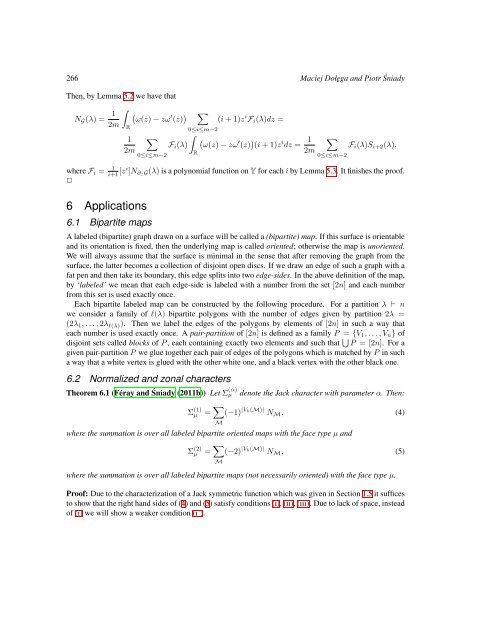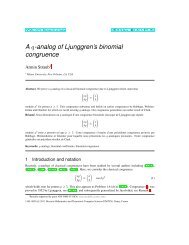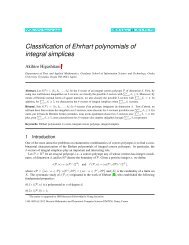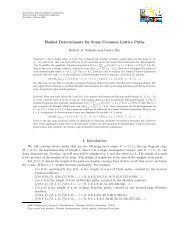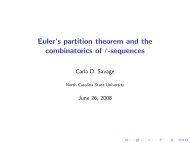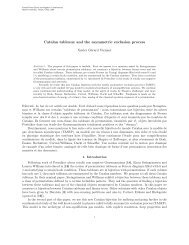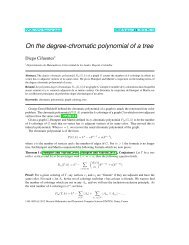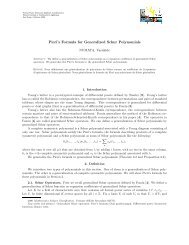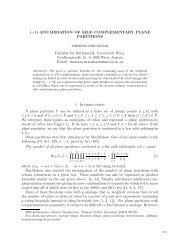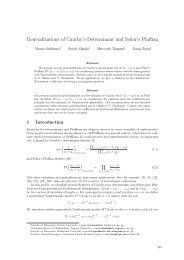Polynomial functions on Young diagrams arising from bipartite graphs
Polynomial functions on Young diagrams arising from bipartite graphs
Polynomial functions on Young diagrams arising from bipartite graphs
You also want an ePaper? Increase the reach of your titles
YUMPU automatically turns print PDFs into web optimized ePapers that Google loves.
266 Maciej Dołęga and Piotr Śniady<br />
Then, by Lemma 5.2 we have that<br />
N G (λ) = 1 ∫<br />
(<br />
ω(z) − zω ′ (z) ) ∑<br />
2m R<br />
∑<br />
∫<br />
1<br />
2m<br />
0≤i≤m−2<br />
F i (λ)<br />
0≤i≤m−2<br />
R<br />
(i + 1)z i F i (λ)dz =<br />
(<br />
ω(z) − zω ′ (z) ) (i + 1)z i dz = 1<br />
2m<br />
∑<br />
0≤i≤m−2<br />
F i (λ)S i+2 (λ),<br />
where F i = 1<br />
i+1 [zi ]N ∂zG(λ) is a polynomial functi<strong>on</strong> <strong>on</strong> Y for each i by Lemma 5.3. It finishes the proof.<br />
✷<br />
6 Applicati<strong>on</strong>s<br />
6.1 Bipartite maps<br />
A labeled (<strong>bipartite</strong>) graph drawn <strong>on</strong> a surface will be called a (<strong>bipartite</strong>) map. If this surface is orientable<br />
and its orientati<strong>on</strong> is fixed, then the underlying map is called oriented; otherwise the map is unoriented.<br />
We will always assume that the surface is minimal in the sense that after removing the graph <strong>from</strong> the<br />
surface, the latter becomes a collecti<strong>on</strong> of disjoint open discs. If we draw an edge of such a graph with a<br />
fat pen and then take its boundary, this edge splits into two edge-sides. In the above definiti<strong>on</strong> of the map,<br />
by ‘labeled’ we mean that each edge-side is labeled with a number <strong>from</strong> the set [2n] and each number<br />
<strong>from</strong> this set is used exactly <strong>on</strong>ce.<br />
Each <strong>bipartite</strong> labeled map can be c<strong>on</strong>structed by the following procedure. For a partiti<strong>on</strong> λ ⊢ n<br />
we c<strong>on</strong>sider a family of l(λ) <strong>bipartite</strong> polyg<strong>on</strong>s with the number of edges given by partiti<strong>on</strong> 2λ =<br />
(2λ 1 , . . . , 2λ l(λ) ). Then we label the edges of the polyg<strong>on</strong>s by elements of [2n] in such a way that<br />
each number is used exactly <strong>on</strong>ce. A pair-partiti<strong>on</strong> of [2n] is defined as a family P = {V 1 , . . . , V n } of<br />
disjoint sets called blocks of P , each c<strong>on</strong>taining exactly two elements and such that ⋃ P = [2n]. For a<br />
given pair-partiti<strong>on</strong> P we glue together each pair of edges of the polyg<strong>on</strong>s which is matched by P in such<br />
a way that a white vertex is glued with the other white <strong>on</strong>e, and a black vertex with the other black <strong>on</strong>e.<br />
6.2 Normalized and z<strong>on</strong>al characters<br />
Theorem 6.1 (Féray and Śniady (2011b)) Let Σ (α)<br />
µ denote the Jack character with parameter α. Then:<br />
Σ (1)<br />
µ = ∑ (−1) |Vb(M)| N M , (4)<br />
M<br />
where the summati<strong>on</strong> is over all labeled <strong>bipartite</strong> oriented maps with the face type µ and<br />
Σ (2)<br />
µ = ∑ (−2) |Vb(M)| N M , (5)<br />
M<br />
where the summati<strong>on</strong> is over all labeled <strong>bipartite</strong> maps (not necessarily oriented) with the face type µ.<br />
Proof: Due to the characterizati<strong>on</strong> of a Jack symmetric functi<strong>on</strong> which was given in Secti<strong>on</strong> 1.5 it suffices<br />
to show that the right hand sides of (4) and (5) satisfy c<strong>on</strong>diti<strong>on</strong>s (i), (ii), (iii). Due to lack of space, instead<br />
of (i) we will show a weaker c<strong>on</strong>diti<strong>on</strong> (i’).


